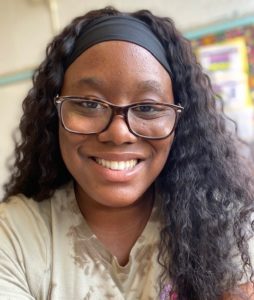We recently spoke with Sanquanita Nellum, 7th and 8th grade Math and Special Education Teacher at George Washington Carver Middle School. She shared the challenges and joys of teaching students with dual barriers to education and how having a strong math curriculum supports their learning.

Sanquanita began her journey as an educator when she became a special education substitute teacher while earning her bachelor’s degree in child development at California State University, Northridge. “You hear stereotypes about children with special needs, but then you discover how smart they are,” she says. “I love building close one-to-one relationships with students.”
After Sanquanita graduated in 2013 and became a mathematics teacher working with special needs students, she discovered that math education differs much more now than when she was a middle school student. In the past, math education was more about memorization and procedure. “We were given one or two different strategies for solving a problem and then we had to solve problems independently with maybe two to three word problems included,” she says.
By contrast, today’s math education puts an emphasis on word problems and learning different ways of approaching problems and identifying patterns. She uses Illustrative Math, a curriculum designed to encourage engaging mathematical discussion, supported by tasks, lesson plans, professional learning, and community. The curriculum makes problems relatable to the everyday lives of students. For example, Sanquanita has used buying tacos as a way to illustrate ratios and unit rate (i.e. if two tacos cost $3.00 then the unit rate is $1.50 per taco.)
When Carver Middle School implemented the math curriculum in 2018, Sanquanita says she initially found it challenging to apply the lessons in the classroom. But after five years as an educator, she’s learned to appreciate how the curriculum supports and advances student learning. “We are teaching our students to be independent, critical thinkers by having them write the steps they took to solve a problem,” she says. “It’s about more than equations or figuring out how to graph. It’s about understanding how to access and use the resources and tools that are available to them. They have the understanding to be successful on their own.”
Sanquanita says that at times it can be challenging to keep up with the pace of the curriculum, especially for special needs students, many of whom are also English learners. “So we put a lot of emphasis on visuals and repetition,” she says. “We also emphasize learning and using academic vocabulary.”
But Sanquanita says that the curriculum also has great rewards for her students because of the academic rigor it provides. “They are doing the same work as the general education classrooms, so when they transition to another classroom they aren’t behind,” she says. The students also appreciate skills they can use in the future. “For example, having students calculate how salaries can be broken down to pay-per-hour makes lessons relatable,” Sanquanita says. ”They are thinking about the problems instead of just completing a task.”
Sanquanita is grateful for the professional support she gets from the Partnership. This includes training facilitated by instructional math experts who have teachers complete the curriculum’s math problems and then discuss different strategies and scaffolds to support students and help them internalize lessons.
In addition, the Partnership provides resources such as geometry toolkits and books, including “Culturally Responsive Teaching and The Brain” by Zaretta L. Hammond, “Mathematical Mindsets” by Jo Boaler, and “Cultivating Genius: An Equity Framework” by Gholdy Muhammad.
Sanquanita also greatly appreciates the support she gets from her math coach, Evelyn Ennis, who is a former teacher from Carver Middle School. “I feel like if I didn’t have a math coach, I wouldn’t be in the position I’m in today,” Sanquanita says. “She’s helping me realize the good things I’m doing in the classroom, such as having higher expectations for my students.”
Sanquanita hopes her students leave her classroom with the knowledge that they are capable of learning and achieving and they can use math tools to drive their education. “I want them to feel seen and heard and to understand that they can do it too,” she says. “Whatever learning disabilities they have are not going to hinder their growth. I also want them to be proud and feel valued and understand what they have to contribute to society.”
